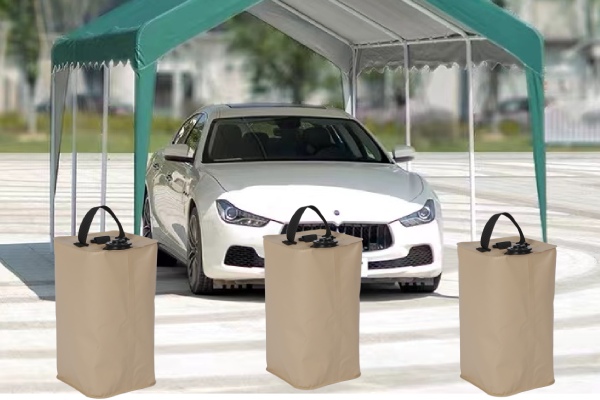All Posts
How to Choose Proper Canopy Weight
When you are engaging in outdoor activities, canopies serve as a clever and quick shelter from the sun and wind. They make you feel comfort and are easily portable. However, these canopies can be lightweight and susceptible to being blown away without the use of canopy weights. Canopy weights can enhance stability and withstand adverse weather conditions, ensuring that your canopy stays securely in place. Canopy weights are especially handy for keeping your tent or canopy poles stable in one location. The canopy weights bag help securing your canopy by attaching to it after filling with water, sand, or gravel. They are easy to transport before their weight is added,then they are inherently heavy.
In this article, we will explore different types of canopy weights and provide purchasing tips, helping you find the ideal tent weight to enhance your outdoor adventure.
Type of Canopy Weights:
1. Sandbags:
Sandbags are the ultimate canopy weights, widely used for decades to provide quick and durable security for temporary shelters in times of need. Canopy weights can be used in extreme weather conditions and are quite cost-effective. However, if you do prone to use them multiple times and anticipate exposure in rain, make sure to buy high-quality, weather-resistant sandbags.
2. Canopy Water Weights:
It is convenient for use when sand or gravel may not be accessible. You are ready to use after filling with water. When done, simply empty them, and they deflate, folding easily for packing with your other belongings. Each bag can hold up to 20 liters of water, applying for various surfaces. Anchor straps are a significant design, securing the water-filled weights firmly attach to the canopy legs and maintaining the structure in the right position in various weather conditions. Top handles on each water weight bag make them easy to carry. They are also fit for canopies, tents, and gazebos.
3. Weight Plates:
It can be attached to your canopy frame and blend well with the overall look of the canopy. Weight plates are flat, plate-shaped,which are designed to be attached to or placed on the legs or corners of a tent to anchor it securely. They are widely used in various applications, including canopy setup, sports equipment, fitness gear, and other instances where additional weight is needed. when put up canopy, weight plates are typically used to secure the canopy to prevent it from being blown away by the wind.
4. Dumbbell or Cinder Block Canopy Weights:
Despite it is not the most aesthetically pleasing option, dumbbells or cinder blocks can be used as DIY canopy weights. The advantage of using dumbbells, expect for providing a small workout , and you can precisely know how much weight you are using to hold the canopy.
5. Cement Block Canopy Weights:
Larger canopies are more susceptible to impact of wind as increased surface area. For 20x20m or more larger canopies, you may need to order large cement block weights. Cement block weights may also be a good option for canopies that need to be set up for an extended period.
Consideration of Purchasing Tent Weights:
1. Slot Size:
Most canopy legs are narrow, specific specifications may vary based on the model. Make sure that the canopy weights you choose are compatible with the structure you are purchasing. The openings should have a perfect size to keep the legs in a comfortable and secure position.
2. Handles:
Even though the weight will be in one position during use, you still need to adjust it at other times. Built-in handles make this awkward process much easier. Check if the handles are sturdy enough to withstand heavy weights and comfortable enough for easy carrying.
3. Anchor Ring Holes:
Canopies often need to be hold with stakes. When this is impractical, weights bag becomes convenient. Some fabric weights come with anchor ring holes, allowing you to secure the canopy to the ground, adding stability under strong wind conditions.
4. Weight:
As a rule of thumb,40 pounds per leg is considered a safe weight to maintain stability.But adjustments can be made based on your requirements and capabilities. The weight should be sufficient to prevent the canopy from being blown away by the wind, keeping it securely anchored to the ground.
5. Material:
If you are using pre-filled weights, be aware that these weights are more compatible with hard surfaces like parking lots and sidewalks. Fillable weights are made of heavy-duty polyester or Oxford fabric with a PVC coating. They maintain stability on soft ground but can tear easily if dragged on rough surfaces. Regardless of the shell material, ensure it is waterproof and durable to bear wear and tear.
6. Durability:
The longer your canopy weights last, the more enjoyment you can expect from your outdoor activities. Test the durability of the weights based on features like reinforced stitching and coatings like PVC or rubber, as they contribute to extending the product’s lifespan. The material should be sturdy enough to withstand extreme weather.
7. Design:
Two main options here are pre-filled and empty weights. You can choose any design element depending on usability and personal preference. Empty weights require filling with sand, gravel, or water. Check if these are easily accessible where you intend to use the weights. Pre-filled weights are more convenient as they do not require filling or emptying. However, the additional weight may not be suitable for travel, so this could be a consideration.
In conclusion, canopy weights are a smart and cost-effective solution to keep your gazebo or canopy tent structure stable in all weather conditions. Choosing the right type and quantity of weights ensures that your canopy can be safely set up in different environments. Whether it’s camping, outdoor markets, music festivals, or other outdoor events, using the appropriate canopy weights is a crucial element in ensuring the smooth progress of activities.

